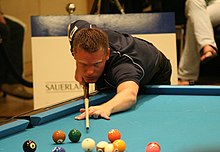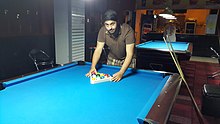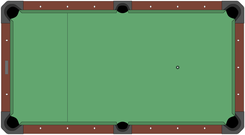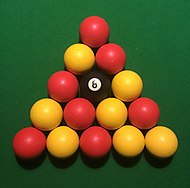Pool (cue sports)


Pool is a classification of cue sports played on a table with six pockets along the rails, into which balls are deposited.[1][2] Each specific pool game has its own name; some of the better-known include eight-ball, blackball, nine-ball, ten-ball, seven-ball, straight pool, one-pocket, and bank pool.
The generic term pocket billiards is sometimes also used, and favored by some pool-industry bodies, but is technically a broader classification, including games such as snooker, Russian pyramid, and kaisa, which are not referred to as pool games. In most parts of the world, it is commonly referred to as just "billiards", analogous to the term "bowling" being commonly used to refer to the game of ten-pin bowling.
There are also hybrid games combining aspects of both pool and carom billiards, such as American four-ball billiards, bottle pool, cowboy pool, and English billiards.
Etymology
This section needs expansion. You can help by . (January 2011) |

The etymology of "pool" is uncertain. The Oxford English Dictionary speculates that "pool" and other games with collective stakes is derived from the French poule (literally translated "hen"), in which the poule is the collected prize; alternatively it could derive from the verb to pool in the sense of combining objects or stakes. The oldest use of the word "pool" to describe a billiards-like game was made in 1797 in a Virginia newspaper.[3] The OED defines it as generally "any of various types of billiards for two or more players" but goes on to note that the first specific meaning of "a game in which each player uses a cue ball of a distinctive colour to pocket the balls of the other player(s) in a certain order, the winner taking all the stakes submitted at the start of the contest" is now obsolete, and its other specific definitions are all for games that originate in the United States.[4] In the British Empire for most of the nineteenth through early twentieth century, pool referred specifically to the game of life pool.[5]:143&187
Although skittle pool is played on a pocketless carom billiards table, the term pool later stuck to all new games of pocket billiards as the sport gained in popularity in the United States,[5]:186 and so outside the cue sports industry, which has long favored the more formal term pocket billiards, the common name for the sport has remained pool. The OxfordDictionaries.com definition no longer even provides the obsolete meaning found in the print edition, and refers only to the typical game "using two sets [each] of seven coloured and numbered balls ... with one black ball and a white cue ball" on a table with pockets.[6]
History
With the exception of one-pocket, games typically called "pool" today are descended from two English games imported to the United States during the 19th century. The first was English billiards which became American four-ball billiards, essentially the same game but with an extra red object ball to increase scoring opportunities. It was the most popular billiards game in the mid-19th century until dethroned by the carom game straight rail. American four-ball tournaments tried switching to carom tables in the 1870s but this did not save it from being doomed to obscurity, the last professional tournament was held in 1876.[5]:5–6 Cowboy pool is a surviving member of this group of games.
The second and more influential game was pyramid pool. By 1850 a variant called fifteen-ball pool became popular. Both games were supplanted by continuous pool in 1888, the immediate forerunner of straight pool (1910).[7]:39–43 New games introduced at the turn of the 20th century include Kelly pool and eight-ball. The distinctive appearance of pool balls with their many colors and division between solid and striped balls came about by 1889.[5]:246 Prior to this, object balls were uniformly deep-red and differentiated only by numbers. English pyramid pool and life pool players were the first to adopt balls with different colors. The stripes were the last addition.[7]:90–91
Equipment

Pool is played on a six pocket table. Modern pool tables generally range in size from 3.5 feet (1.07 m) by 7 feet (2.13 m), to 4.5 feet (1.37 m) by 9 feet (2.74 m).
The balls range from 2.25 inches (57.15 mm) in diameter to 2.375 inches (60.33 mm) in diameter.[8] Under the WPA/BCA (see below) equipment specifications, the weight may be from 5.5 to 6 oz. (156–170 g) with a diameter of 2.25 in. (57.15 mm), plus or minus 0.005 in. (0.127 mm).[9][10] Modern coin-operated pool tables generally use one of three methods to distinguish and return the cue ball to the front of the table while the numbered balls return to an inaccessible receptacle until paid for again: the cue ball is larger and heavier than the other balls, or denser and heavier, or has a magnetic core.
Modern cue sticks are generally 58.5 inches (148.6 cm) long for pool while cues prior to 1980 were designed for straight pool and had an average length of 57.5 inches (146.1 cm). By comparison, carom billiards cues are generally shorter with larger tips, and snooker cues longer with smaller tips.
Game types
Racked games
These are games descended from the early 19th century games of pyramid pool and fifteen-ball pool which required balls to be racked due to the large number of them on the table. Of the other pyramid traditions of Continental Europe, only Russian pyramid survives. Snooker, originally known as snooker's pool, can be considered a member of this family. One-pocket initially did not require a rack, it was originally played with just three balls.[11] Conversely, Chicago dispensed with a rack when it emerged from 61. The following games share common equipment such as tables and balls.
Rotation games

Rotation games require players to make legal contact with the lowest numbered ball on the table or a foul is called. The earliest rotation game, originally known as 61, started off as a variant of fifteen-ball pool during the mid-nineteenth century. The name "rotation" came from how the balls were placed around the table in its unracked offshoot Chicago. 61 has spawned many variations of its own such as American rotation, seven-ball, nine-ball, ten-ball, and Kelly pool. Of these, nine-ball is the most popular and the predominant professional game with ten-ball as its greatest competitor.[12][clarification needed] There are many local and regional tours and tournaments that are contested with nine-ball. The World Pool-Billiard Association (WPA) and its American affiliate, the Billiard Congress of America (BCA), publish the World Standardized Rules. The European professional circuit has instituted rules changes to make it more difficult to achieve a legal break shot.[12][13]
The largest nine-ball tournaments are the independent US Open Nine-ball Championship and the WPA World Nine-ball Championship for men and women. Male professionals have a rather fragmented schedule of professional nine-ball tournaments. The United States Professional Poolplayers Association (UPA) has been the most dominant association of the 1990s and 2000s. A hotly contested event is the annual Mosconi Cup, which pits invitational European and U.S. teams against each other in one-on-one and scotch doubles nine-ball matches over a period of several days. The Mosconi Cup games are played under the more stringent European rules, as of 2007.[13]
Three-ball originated as a rotation game but the folk rules have changed considerably since the 1980s. It is now generally played such that the player at turn continues shooting until all the balls are pocketed, and the player to do so in the fewest shots wins. It dispenses with some fouls common to both nine- and eight-ball.
Straight pool
Also known as 14.1 continuous, this game originated as a slight modification of continuous pool, another offshoot of fifteen-ball pool. The shooter may attempt to shoot at any object ball on the table. The goal is to reach a set number of points determined by agreement before the game. One point is scored for each object ball pocketed where no foul is made. A typical game might require a player to score 100 points to win. In professional competition, straight pool is usually played to 125 points. Straight pool is a call-pocket game, meaning the player must indicate the intended object ball and pocket on every shot.
Eight-ball
In the United States, the most commonly played pool game is eight-ball, which appeared at the beginning of the twentieth century. The goal of eight-ball, which is played with a full rack of fifteen balls and the cue ball, is to claim a suit (commonly stripes or solids in the US, and reds or yellows in the UK), pocket all of them, then legally pocket the 8 ball, while denying one's opponent opportunities to do the same with their suit, and without sinking the 8 ball early by accident. In the United Kingdom the game is commonly played in pubs, and it is competitively played in leagues on both sides of the Atlantic. The most prestigious tournaments including the World Open are sponsored and sanctioned by the International Pool Tour. Rules vary widely from place to place (and between continents to such an extent that British-style eight-ball pool/blackball is properly regarded as a separate game in its own right). Pool halls in North America are increasingly settling upon the World Pool-Billiard Association International Standardized Rules. But tavern eight-ball (also known as "bar pool"), typically played on smaller, coin-operated tables and in a "winner keeps the table" manner, can differ significantly even between two venues in the same city. The growth of local, regional and national amateur leagues may alleviate this confusion eventually.
One-pocket
One-pocket owes its origins to 18th century cramp (handicapped) games. It is a strategic game for two players in which each player is assigned one of the corner pockets on the table. This is the only pocket into which he can legally pocket balls. The first player to pocket the majority of the balls (8) in his pocket wins the game. The game requires far more defensive strategy than offensive strategy, much unlike eight-ball, nine-ball, or straight pool. Most times, accomplished players choose to position balls near their pocket instead of trying to actually pocket them. This allows them to control the game by forcing their opponent to be on defense instead of taking a low percentage shot that could result in a loss of game. These low percentage shots are known as "flyers" by one-pocket aficionados.
Bank pool
Bank pool can be played with a full rack (can be a long game), but is more typically played with nine balls (frequently called "nine-ball bank"). The balls are racked in nine-ball formation, but in no particular order. The object of the game is simple: to be the first player to bank five balls in any order (eight balls when played with a full rack). Penalties and fouls are similar to one pocket in that the player committing the foul must spot a ball for each foul. This must be done before the incoming player shoots.
Artistic pool
Artistic pool is the competitive discipline of trick shots inspired by its carom equivalent. Played on pool or snooker tables, players must complete a set number of shots of varying difficulty.
Hybrid carom or obstacle games
Cowboy pool and bottle pool are games involving only a few balls which are placed at specific spots on the table. Elements of their games go back to the eighteenth century before balls needed to be racked. Bottle pool shares traits with pin billiards games such as Danish pin billiards. Cowboy pool is a descendant of English billiards. Kaisa is a similar game played with different equipment.
Governing bodies
As a competitive sport, pool is governed internationally by the World Pool-Billiard Association (WPA), which has multi-national, regional affiliates comprising the (AAPA), Asian Pocket Billiard Union (APBU, including the Middle East), Billiard Congress of America (BCA, Canada and the US), Confederación Panamericana de Billar (CPB, Latin America and Caribbean), European Pocket Billiard Federation (EPBF, including Russia and the Near East), and Oceania Pocket Billiard Association (OPBA, Australia, New Zealand, Pacific islands). The WPA represents pool in the World Confederation of Billiards Sports, which in turn represents all forms of cue sports (including carom billiards and snooker) in the International Olympic Committee.
Notes
- ^ "The Official Website for the Governing Body of Pool". WPA-Pool.com. Sydney, Australia: World Pool-Billiard Association (WPA). 2011. banner, copyright notice, etc. Retrieved November 4, 2011. "Pool billiards" is sometimes hyphenated and/or spelled with a singular "billiard". The WPA itself uses "pool-billiard" in its logo but "pool-billiards" in its legal notices. The organization compounds the words to result in an acronym of "WPA", "WPBA" having already been taken by the Women's Professional Billiards Association. Normal English grammar would not hyphenate here, and the term is actually a Germanism.
- ^ Game Rules for... Six-pocket. Amityville, New York: U.S. Billiards, Inc. c. 1970. A general rules booklet on pool games in general, including eight-ball, nine-ball and several others.
- ^ "entry for Pool, n.3". Oxford English Dictionary. Retrieved 15 February 2018.
- ^ "pool, n., 3.2". Oxford English Dictionary (Third ed.). Oxford University Press. September 2011 [2006]. Retrieved September 30, 2011 – via OED.com. (subscription required)
- ^ Jump up to: a b c d Shamos, Mike (1999). The New Illustrated Encyclopedia of Billiards. New York: Lyons Press. ISBN 1-55821-797-5.
- ^ "pool, 2, noun, 2". OxfordDictionaries.com. British and World English. Oxford University Press. 2016. Retrieved July 15, 2016.
- ^ Jump up to: a b Shamos, Mike (1994). Pool. New York City: Friedman Fairfax.
- ^ "World Rules of Carom Carom Billiard" (PDF). UMB.org. Sint-Martens-Latem, Belgium: Union Mondiale de Billard. January 1, 1989. Chapter II ("Equipment"), Article 12 ("Balls, Chalk"), Section 2. Archived from the original (PDF) on September 28, 2007. Retrieved March 5, 2007.Officially but somewhat poorly translated version, from the French original.
- ^ "WPA Tournament Table & Equipment Specifications" Archived 2011-02-18 at the Wayback Machine, World Pool-Billiard Association, November 2001.
- ^ BCA Rules Committee (2004). Billiards: The Official Rules and Records Book. Colorado Springs, Colorado: Billiards Congress of America. p. 5. ISBN 978-1-878493-14-9.
- ^ Roberts, John (1869). Roberts on Billiards (2nd ed.). London: Stanley Rivers and Co. p. 187. Retrieved 26 April 2019.
- ^ Jump up to: a b Varner, Nick (February 2008). "Killing Me Softly? The Outbreak of the Soft Break Threatens the Game of 9-ball". Billiards Digest. 30 (3). Chicago: Luby Publishing. pp. 4–35. ISSN 0164-761X.CS1 maint: postscript (link)
- ^ Jump up to: a b Panozzo, Mike (February 2008). "Long Live the Cup!". Billiards Digest. 30 (3). Chicago: Luby Publishing. pp. 34–35. ISSN 0164-761X.CS1 maint: postscript (link)
References
| Wikimedia Commons has media related to Pool (cue sports). |
- Shamos, Mike (1999). The New Illustrated Encyclopedia of Billiards. New York: Lyons Press. ISBN 1-55821-797-5.
- Byrne, Robert (1978), Byrne's Standard Book of Pool and Billiards, New York and London: Harcourt Brace Jovanovich, ISBN 0-15-115223-3
- Pool (cue sports)
- Pub games


